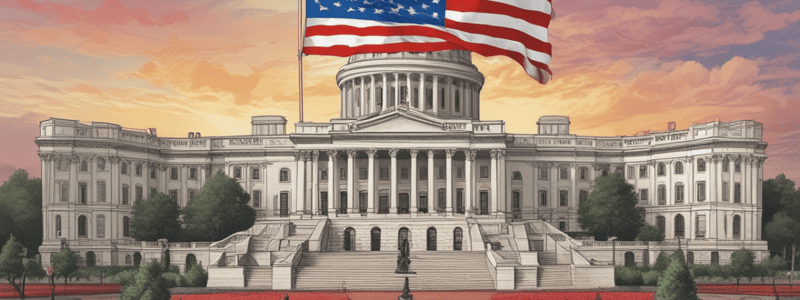Podcast
Questions and Answers
What is the first step a proposed bill undergoes after being introduced in Congress?
What is the first step a proposed bill undergoes after being introduced in Congress?
The bill is referred to a committee for review and possible amendments.
What happens if a committee does not schedule a debate for a bill?
What happens if a committee does not schedule a debate for a bill?
The bill can be effectively killed and not proceed further.
What occurs if both chambers of Congress pass similar bills?
What occurs if both chambers of Congress pass similar bills?
The bills are sent to a conference committee to resolve differences before being sent to the president.
What action can the president take after receiving a bill from Congress?
What action can the president take after receiving a bill from Congress?
What happens to a bill if Congress adjourns before the ten-day period expires and the president does not sign it?
What happens to a bill if Congress adjourns before the ten-day period expires and the president does not sign it?
Flashcards are hidden until you start studying
Study Notes
The Legislative Process
- Any member of the Senate or House of Representatives can propose a bill, but party leaders typically introduce it.
- Similar bills may be introduced in both chambers of Congress at the same time.
- After initial reading, a bill is referred to a committee (and possibly a subcommittee) for review, amendments, and input from government agencies and the public.
- Committees can kill a bill by refusing to consider it.
- After committee approval, the bill returns to its chamber of origin for debate and vote.
- The Speaker of the House or Senate Majority Leader can also kill a bill by not scheduling it.
- If the bill passes, it is sent to the other chamber for committee consideration, debate, and vote.
- If both chambers pass the bill, it proceeds to the president for signature or veto.
Bill Passage Between Chambers
- If both chambers pass similar bills, the legislation goes to a conference committee for compromise.
- The conference committee sends a report to both chambers outlining the agreement.
- The report goes to the president for approval if both chambers approve it.
- If the president signs the bill, it becomes law.
Presidential Action
- The president can veto a bill, returning it to Congress for a possible override vote.
- If Congress is in session and the president does nothing, the bill automatically becomes law after ten days.
- If Congress adjourns before the ten days pass, the bill dies.
Studying That Suits You
Use AI to generate personalized quizzes and flashcards to suit your learning preferences.




